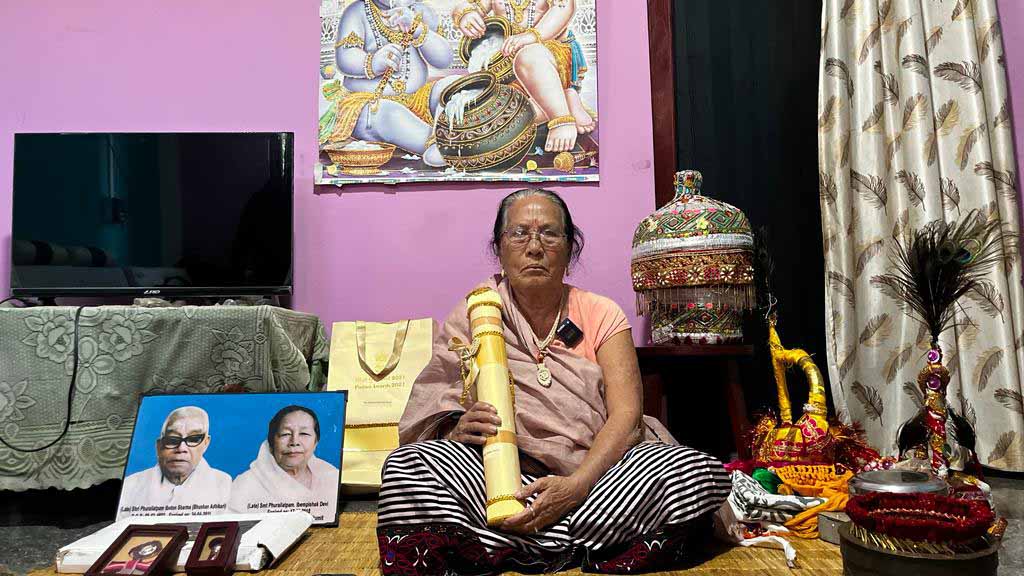Modifying the wedding dress of Meitei Hindu, Potloi in its design and colour combination has become a new normal nowadays. Many seasoned Potloi artisan observed this changing trend as a threat of undermining the traditional and cultural values of Potloi.
Manipur is known for its rich culture and tradition. The Manipuri traditional wedding ceremony which is considered to be auspicious and scared also plays great role in reflecting its culture and tradition.
In Meitei society who follow Hinduism, bride adorns “Potloi” as a wedding dress. When the bride wears Potloi, the colour of the Potloi should be red, ‘Lisol Furit’ (suede blouse) should be green and ‘Innaphi’ (shawl). This particular colour combination has its own significance and it has been carried on since many years. But unfortunately, this outfit introduced by the then king Maharaj Bhagyachandra has been change potloi by customising to a great extent wherein one has opted any colour and patterns according to their preference.
To know some insights of Potloi, this reporter had interacted with padmashree awardee, Hanjabam Radhe, a renowned artist in the field of Potloi making and dressing.
Hanjabam Radhe who is her 90s from Wangjing Sorokhaibam Leikai and started working as Potloi dresser or Potloi setpi (Manipuri language) when she was in 25 years old said that Potloi is one of the most important and valuable costume of Manipur. It is a custom that wears not only in wedding but also in Ras Leela which was introduced by the then King Bhagyachandra.
Marriage is compulsion to everyone’s life. Every human who are born as woman are bound to wear it Potloi at least once in their life on the day of wedding which we considered as auspicious and sacred occasion. But in due course of time, Potloi which hold significant place in showing cultural identity of Meitei Hindu has changed to a great extent. The pattern and design of Potloi is heavily decorated and colour are opted as per choice. Such changes should be prohibited because it will give serious threat to cultural and traditional values of Potloi, said Radhe while recollecting how she started her profession of Potloi making and dressing.
“I have started the profession of Potloi making and Potloi dressing from the age of 25 years under the guidance of my sister from my locality. From the following year, I have started the service of Potloi wearing and making all alone as my guide has confident that I can do it. My guide took order for me and my first service was given at Irengband Village at the charge of Rs 150. Since then i have started contributing financial support to my family. In this long stint of Potloi making and dressing, I see many changes. I feel so worried on this because it is not good and also poses serious threat to traditional potloi that has been wearing for generations,” Radhe who had dressed over 1000 plus brides with her own hand-making Potloi’s.
Radhe said that Potloi is associated with Bhakti Ras and signifies the picture of a disciplined culture. But with the addition of random patterns, design and colour and influence of other societies have distorted the breathtaking attire.
The motif and colour combination has an in-depth meaning of their own. ‘Red’ colour of the potloi signifies the Kali Shakti, ‘Green’ colour of the suede blouse signifies nature and the ‘White’ colour of the inaphi (shawl) carries a pledge that she will take care of the new family members with love and care, she informed while stating that the present generation should at least preserve the basic things.
Talking about the pattern embroidered in the Potloi, Radhe said that the sacred pattern of Pakhangba is also included in Potloi. But this is also distorted by the current generation defying its actual look which is very unfortunate.
Recalling about how Potloi was make in her time, she said that Potloi making is an art inherited from forefather. A Potloi designer takes at least 15 days to complete one Potloi in her time as it is completely a handiwork job.
Earlier Potloi costume is made from bamboo and cloth dipped in starch to take a cylindrical shape. Colourful stones, glitters and glittering clothes are stitch to the velvety cloth. But nowadays, making a Potloi is not that tough as starch cloth is replace by rubber sheet. With this very reason, number of Potloi maker are increasing continuously.
During the interaction, paying respect to her guru who had guided her in Potloi making and dressing, she kept the portrait of her guru late Phurailatpam Iboton Sharma and his wife late Phurailatpam Ibempishak Devi at her side.
She holds padmashree award certificate in her hands and presented the interview. As a part of the interview, she demonstrated Potloi and accessories adorn by a bride on the day of wedding. to maintain and preserve its traditional style, uniqueness and importance.
Radhe at the end of the interview urged the present generation who have taken up the profession of Potloi crafting to maintain and preserve its traditional style, uniqueness and significance.












